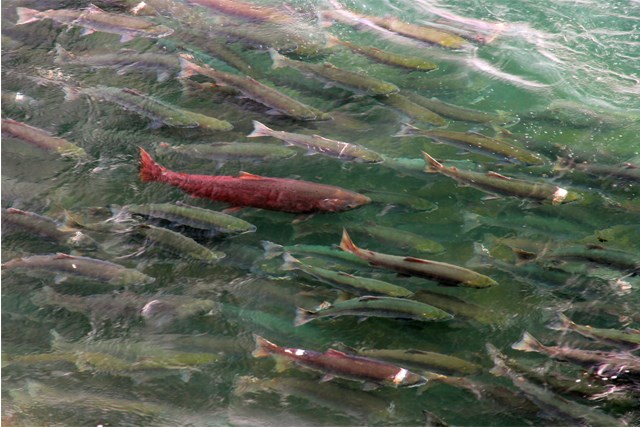|
Sockeye / red salmon (Oncorhynchus nerka) are a critical component in most of Lake Clark's ecosystems. Through ongoing monitoring and a variety of research projects, biologists have been able gain key insights into the sockeye population dynamics within the park and preserve.
Visit our keyboard shortcuts docs for details
Sockeye salmon are a critical part of the Lake Clark story. Through ongoing monitoring and a variety of research projects, park scientists have been able to track the population and gain key insights into the lives of Lake Clark's sockeye salmon. An Audio Described version of this film is available at: https://youtu.be/GtSsCdbVn-U A Massive Migration Each year an average of 372,000 sockeye, or red salmon swim up the Newhalen River and enter the waters of Lake Clark National Park and Preserve. These sockeye are returning to the creeks, streams and lakes where they were born. Sockeye are born in freshwater. After a year or two in freshwater they migrate out to the ocean where they spend another one to three years. Near the end of their lives they travel back to the places where they hatched to spawn and soon afterward die. Sockeye salmon are a critical part of the Lake Clark story. The park was established in part to protect sockeye salmon and their habitat. Sockeye are a keystone species in the park’s ecosystems, providing nutrients to life at all levels of the food chain. Without them, Lake Clark would be like a house with an empty pantry. Another reason for the creation of Lake Clark National Park was to protect subsistence use of resources, which includes sockeye salmon. Sockeye are a critical subsistence species for local people. The communities in and around the park are not connected to Alaska’s road system. As a result, people living in around the park depend on hunting, fishing and gathering to help put food on the table. For the Dena’ina Athabascan people who've lived in the area for more than a thousand years, subsistence use of sockeye is about more than just a putting food on the table. It’s one piece of a larger tradition of living with and caring for the land. Sockeye Science Because sockeye salmon are so important, the National Park Service (NPS) has been monitoring the population since 2000. The NPS aren't the first people to count salmon on the Newhalen River. The University of Washington counted sockeye on and off from the 1950's to the 1980's. By using the same counting methods as past researchers park scientists have been able to build on their work and see short, medium, and long term trends in the population. 
NPS Photo / S. Huffman In addition to counting fish, park scientist have done extensive work looking at key aspects of the sockeye’s life cycle in the park. Using radio tracking technology, park scientists identified 32 distinct spawning grounds in the Lake Clark watershed. Of those, 5 are identified as key areas, where almost ¾ of the sockeye sampled spawned. This work has also shown the importance of glacially turbid streams and rivers as spawning habitat for sockeye in the park. Park scientist have located 18 previously unidentified spawning grounds, where about 65% of Lake Clark sockeye spawn. Genetics research on sockeye spawning in these glacially turbid systems is the first to show local adaptation to these habitats. Glacially spawning sockeye have a number of features that make them distinct. One of them is their snout. During their migration back to fresh water sockeye develop an elongated snout with large sharp teeth. They use their snout during spawning for protection and as a weapon. Usually longer snouts are correlated with higher density spawning areas. With more fish around there is bound to be more competition and conflict. Lake Clark sockeye spawning in glacially turbid habitats generally have longer snouts than fish spawning in non-glacial habitats. This is probably due to the decreased visibility. The visual cues that sockeye use to communicate during spawning are not as effective in turbid water. As a result the likelihood of aggressive encounters between competing individuals increases. So does the value of having a bigger snout for protection. |
Last updated: September 10, 2018
